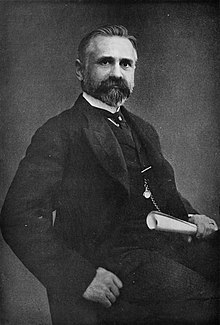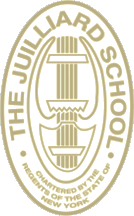
Frank Heino Damrosch (June 22, 1859 – October 22, 1937) was a German-born American music conductor and educator. In 1905, Damrosch founded the New York Institute of Musical Art, a predecessor of the Juilliard School.

Frank Heino Damrosch (June 22, 1859 – October 22, 1937) was a German-born American music conductor and educator. In 1905, Damrosch founded the New York Institute of Musical Art, a predecessor of the Juilliard School.

Damrosch was born on June 22, 1859, in Breslau, Silesia, the son of Helene von Heimburg, a former opera singer, and conductor Leopold Damrosch. He came to the United States with his father, brother, conductor Walter Damrosch, and sister, music teacher Clara Mannes, in 1871. His parents were Lutheran. [1] [2] [3]
He had studied music in Germany under Dionys Pruckner. He studied in New York under Ferdinand von Inten. He also studied in Europe under Moritz Moszkowski. He had originally intended to adopt a business career, and to that end went to Denver, Colorado, but the musical impulse proved too strong, and, in 1884, he was an organist, conductor of the Denver Chorus Club, and supervisor of music in the public schools.
For some years he was chorus master at the Metropolitan Opera House in New York. He also conducted the Mendelssohn Glee Club from 1885 to 1887. In 1892, he organized the People's Singing Classes, and he was also instrumental in founding the Musical Art Society of New York.
In 1897, he became supervisor of music in the public schools in New York. In 1898 Damrosch succeeded his brother Walter as conductor of the Oratorio Society, which he directed until 1912. During his career, he and his sister Clara Damrosch also taught at the Veltin School for Girls in Manhattan. [4]
In 1905, he founded and became director of the New York Institute of Musical Art, with the hopes of reproducing the quality of instruction found in European conservatories. In 1926, the Institute of Musical Art merged with the Juilliard Graduate School to form what is today Juilliard School. Damrosch's pupils included William Howland, long-time head of the music department at the University of Michigan, [5] and the prodigy pianist Hazel Scott. [6]
Damrosch died in New York City on October 22, 1937, aged 78. [7] Damrosch Park, part of New York's Lincoln Center for the Performing Arts, is named in honor of the Damrosch family.

The Juilliard School is a private performing arts conservatory in New York City. Founded by Frank Damrosch as the Institute of Musical Art in 1905, the school later added dance and drama programs and became the Juilliard School, named after its principal benefactor Augustus D. Juilliard.

Augustus D. Juilliard was an American businessman and philanthropist, born at sea as his parents were immigrating to the United States from France. Making a successful career in New York City, he bequeathed much of his estate to the advancement of music in the United States.
The Mannes School of Music, originally called the David Mannes Music School and later the Mannes Music School, Mannes College of Music, the Chatham Square Music School, and Mannes College: The New School for Music, is a music conservatory in The New School, a private research university in New York City. In the fall of 2015, Mannes moved from its previous location on Manhattan's Upper West Side to join the rest of the New School campus in Arnhold Hall at 55 W. 13th Street.

Robert Nathaniel Mann was a violinist, composer, conductor, and founding member of the Juilliard String Quartet, as well as a faculty member at the Manhattan School of Music. Mann, the first violinist at Juilliard, served on the school's string quartet for over fifty years until his retirement in 1997.

Walter Johannes Damrosch was a Prussian-born American conductor and composer. He was the director of the New York Symphony Orchestra and conducted the world premiere performances of various works, including Aaron Copland's Symphony for Organ and Orchestra, George Gershwin's Piano Concerto in F and An American in Paris, and Jean Sibelius' Tapiola. Damrosch was also instrumental in the founding of Carnegie Hall. He also conducted the first performance of Rachmaninoff's Piano Concerto No. 3 with the composer himself as soloist.

Leopold Damrosch was a German American orchestral conductor, composer, violinist, and teacher. He was the patriarch of the Damrosch family, which includes Frank Damrosch and Walter Damrosch.
Clara Mannes was a German-born American musician and music educator. She and her brother Frank Damrosch also taught at the Veltin School for Girls in Manhattan. With her husband, David Mannes, she founded the David Mannes Music School in 1916, now known as the Mannes School of Music at the New School.

Ernest Hutcheson was an Australian pianist, composer and teacher.

Albert Frederic Stoessel was an American composer, violinist and conductor.

Leopold Damrosch Mannes was an American musician, who, together with Leopold Godowsky Jr., created the first practical color transparency film, Kodachrome.

David Mannes was an American violinist, conductor, educator, and community organizer.

Mischa Levitzki was a Russian-born U.S.-based concert pianist and composer.

Emma Margarete "Gretchen" Dessoff was a German choral conductor, singer, and voice teacher.

Vincent Fanelli, Jr. was an American harpist, teacher, and handball enthusiast.
Martha Lipton was an American operatic mezzo-soprano and music educator who is best known for her career performing at the Metropolitan Opera from 1944-1961. A native of New York City, she began her training as a vocalist with her mother who had a brief career as a concert soprano under the name Estelle Laiken. She later studied both privately and at the School of Musicianship for Singers, Inc and the Juilliard School. She made her professional concert debut while still a student in 1933 at Carnegie Hall, performing in a concert of light opera excerpts with the New York Light Opera Guild. In 1936 she began working as a church vocalist at both Riverside Church and Temple Emanu-El of New York.
Victoria Ellen Bond is an American conductor and composer in New York City.
The Chattanooga Symphony and Opera, also known as CSO, is a combined symphony orchestra and opera company in Chattanooga, Tennessee. At the time of the merger in 1985, it was the only such combined organization in the United States.

Lucia Dunham was an American voice teacher, classical soprano, and academic writer on singing and diction who is chiefly remembered as a longtime professor of vocal performance at the Juilliard School from 1922-1956.

Helen Damrosch Tee-Van was a German-American illustrator best known for her precise scientific illustrations. Between 1922 and 1963, she participated in 13 international expeditions with the New York Zoological Society to document new species. Most notably, the illustrator was part of the Arcturus expedition, the organization's first oceanographic expedition, led by William Beebe.

Franz Kneisel was a violinist, conductor, and music teacher.
| Archives at | ||||||
|---|---|---|---|---|---|---|
| ||||||
| How to use archival material |